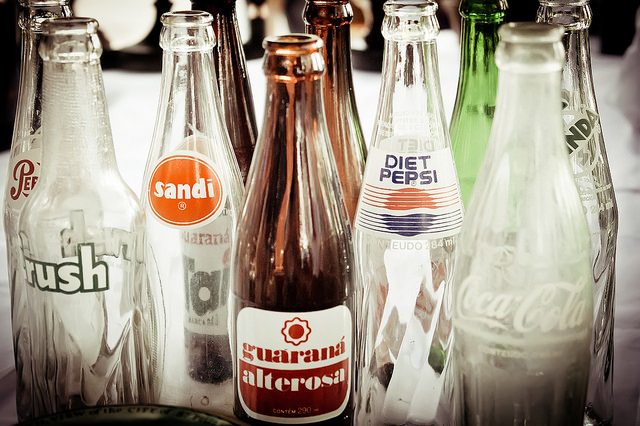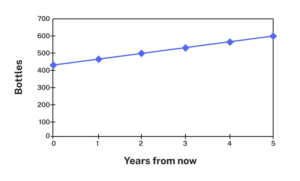- Identify whether a scenario or data describes linear or geometric growth
- Identify key growth parameters, such as growth rates and initial values, and express them in a format that can be used for calculation
- Use equations to predict future values for linear and exponential growth
Predicting Growth
Marco is a collector of antique soda bottles. His collection currently contains [latex]437[/latex] bottles. Every year, he budgets enough money to buy [latex]32[/latex] new bottles. Can we determine how many bottles he will have in [latex]5[/latex] years, and how long it will take for his collection to reach [latex]1000[/latex] bottles?

While you could probably solve both of these questions without an equation or formal mathematics, we are going to formalize our approach to this problem to provide a means to answer more complicated questions.
recursive relationships
A recursive relationship is a formula that relates the next value in a sequence to the previous values.
The subscripts on the variables below, [latex]P_n[/latex], represent the order of the steps.
Suppose that [latex]P_n[/latex] represents the number, or population, of bottles Marco has after [latex]n[/latex] years. So [latex]P_0[/latex] would represent the number of bottles now, [latex]P_1[/latex] would represent the number of bottles after [latex]1[/latex] year, [latex]P_2[/latex] would represent the number of bottles after [latex]2[/latex] years, and so on. We could describe how Marco’s bottle collection is changing using:
[latex]P_0 = 437[/latex]
[latex]P_n= P_{n-1} + 32[/latex]
This is called a recursive relationship. Here, the number of bottles in year n can be found by adding [latex]32[/latex] to the number of bottles in the previous year, [latex]P_{n-1}[/latex]. Using this relationship, we could calculate:
[latex]P_1 = P_0 + 32 = 437 + 32 = 469[/latex]
[latex]P_2 = P_1 + 32 = 469 + 32 = 501[/latex]
[latex]P_3 = P_2 + 32 = 501 + 32 = 533[/latex]
[latex]P_4 = P_3 + 32 = 533 + 32 = 565[/latex]
[latex]P_5 = P_4 + 32 = 565 + 32 = 597[/latex]
We have answered the question of how many bottles Marco will have in [latex]5[/latex] years.

However, solving how long it will take for his collection to reach [latex]1000[/latex] bottles would require a lot more calculations.
Ex. [latex]P_1=437+32[/latex] may be read, “the total number of bottles after one year is equal to the initial number of [latex]437[/latex] bottles increased by [latex]32[/latex] in the first year”. Furthermore, that tells us that at the end of the first year, Marco will have [latex]437[/latex] bottles plus [latex]1[/latex] set of [latex]32[/latex] added during the year.
Ex. [latex]P_2=437 + 2(32)[/latex] may be read, “at the end of the 2nd year, the initial collection of [latex]437[/latex] bottles has been increased by [latex]2[/latex] sets of [latex]32[/latex], since [latex]32[/latex] bottles were added during each of the years.”
Translating between the real-world situation and the mathematical notation as you work through an example can help you to understand the process being used to create the explicit equation that describes the situation.
While recursive relationships are excellent for describing simply and cleanly how a quantity is changing, they are not convenient for making predictions or solving problems that stretch far into the future. For that, a closed or explicit form for the relationship is preferred. An explicit equation allows us to calculate [latex]P_n[/latex] directly, without needing to know [latex]P_{n-1}[/latex]. While you may already be able to guess the explicit equation, let us derive it from the recursive formula. We can do so by selectively not simplifying as we go:
[latex]\begin{array}{rcl}
P_1 & = & 437 + 32 \\
& = & 437 + 1(32) \\[5pt]
P_2 & = & P_1 + 32 \\
& = & 437 + 32 + 32 \\
& = & 437 + 2(32) \\[5pt]
P_3 & = & P_2 + 32 \\
& = & (437 + 2(32)) + 32 \\
& = & 437 + 3(32) \\[5pt]
P_4 & = & P_3 + 32 \\
& = & (437 + 3(32)) + 32 \\
& = & 437 + 4(32) \\
\end{array}
[/latex]
You can probably see the pattern now, and generalize that
[latex]P_n = 437 + n(32) = 437 + 32n[/latex]
Using this equation, we can calculate how many bottles he’ll have after [latex]5[/latex] years:
[latex]P_5 = 437 + 32(5) = 437 + 160 = 597[/latex]
We can now also solve for when the collection will reach [latex]1000[/latex] bottles by substituting in [latex]1000[/latex] for [latex]P_n[/latex] and solving for [latex]n[/latex]
[latex]1000 = 437 + 32(n)[/latex]
[latex]563 = 32(n)[/latex]
[latex]n = 563/32 \approx 17.59[/latex]
So Marco will reach [latex]1000[/latex] bottles in [latex]18[/latex] years.